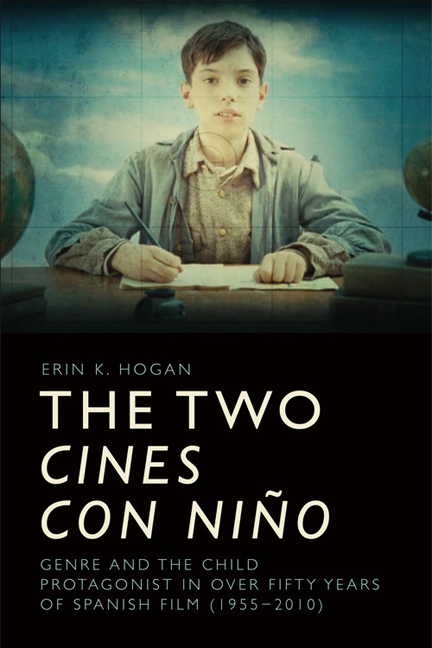Book contents
- Frontmatter
- Contents
- List of Figures
- Acknowledgements
- Figure Permissions
- Introduction The Two Cines Con Niño: The Ventriloquism, Dialogism and Biopolitics of the Children of Franco in Genre Film
- 1 The Black Market and the Stolen Children of Franco in Demonios En El Jardín
- 2 The Appropriative and Carnivalesque Ventriloquism of Altar Boys from Joselito in El pequeño ruiseñor to Ignacio in La mala Educación
- 3 Ventriloquism, Kidnapping and the Carnivalesque in Marisol’s Tómbola
- 4 Adopting, Adapting and Appropriating in the cines con niño: Un rayo de luz and El viaje de Carol
- 5 Prosopopeia and the Gothic Child from Marcelino pan y vino to El Orfanato
- 6 Dialogism and Ritual Function of the Nuevo Cine Con Niño: El Espíritu De La Colmena, Secretos Del Corazón And El Laberinto Del Fauno
- 7 Queering Post-war Childhood in Urte Ilunak and Pa Negre
- 8 The Transatlantic Dialogism in Narrative and Aesthetics of Bildungsfilms: La Lengua De Las Mariposas, Machuca, El Espíritu De La Colmena, El Premio, El Laberinto Del Fauno And Infancia Clandestina
- Conclusion Spanish Movies: Genre, Nation and Spanish Movie
- Select Filmography
- Select Bibliography
- Index
Introduction The Two Cines Con Niño: The Ventriloquism, Dialogism and Biopolitics of the Children of Franco in Genre Film
Published online by Cambridge University Press: 01 May 2021
- Frontmatter
- Contents
- List of Figures
- Acknowledgements
- Figure Permissions
- Introduction The Two Cines Con Niño: The Ventriloquism, Dialogism and Biopolitics of the Children of Franco in Genre Film
- 1 The Black Market and the Stolen Children of Franco in Demonios En El Jardín
- 2 The Appropriative and Carnivalesque Ventriloquism of Altar Boys from Joselito in El pequeño ruiseñor to Ignacio in La mala Educación
- 3 Ventriloquism, Kidnapping and the Carnivalesque in Marisol’s Tómbola
- 4 Adopting, Adapting and Appropriating in the cines con niño: Un rayo de luz and El viaje de Carol
- 5 Prosopopeia and the Gothic Child from Marcelino pan y vino to El Orfanato
- 6 Dialogism and Ritual Function of the Nuevo Cine Con Niño: El Espíritu De La Colmena, Secretos Del Corazón And El Laberinto Del Fauno
- 7 Queering Post-war Childhood in Urte Ilunak and Pa Negre
- 8 The Transatlantic Dialogism in Narrative and Aesthetics of Bildungsfilms: La Lengua De Las Mariposas, Machuca, El Espíritu De La Colmena, El Premio, El Laberinto Del Fauno And Infancia Clandestina
- Conclusion Spanish Movies: Genre, Nation and Spanish Movie
- Select Filmography
- Select Bibliography
- Index
Summary
Franco, ese ventrílocuo
A retrospective piece from the traditionally centre-left Spanish newspaper El País on Francisco Franco's thirty-six-year dictatorship for the fortieth anniversary of his death on 20 November showcases the biopolitics of the military regime with a focus on the original child of Franco, his own daughter Carmencita (1926–2017), and Franco's ventriloquism of her. Manuel Jabois's ‘Carmencita y el amor’ (Carmencita and Love) from 22 November 2015 is an ironic declaration of love for the former dictator's daughter ‘Nenuca’ that departs from the now infamous newsreel, from the penultimate year of the Spanish Civil War, ‘Franco en Salamanca II’ (Franco in Salamanca II) (Amo 1996: 449–50). The performance of the national family is a ventriloquist act that casts the dictator, demonstrated in fullest etymological expression, as ventriloquist who controls the speech of Carmencita, his child dummy. Franco dictates Carmencita's ideology-ridden lines that Chapter One will explore in further detail. As the dummy addresses the children of the world, Franco mouths her words. Carmen Polo, wife and mother, plays only a literally supporting role, with no lines, as the lap on which Carmencita sits. In accordance with Foucauldian and Agambenian biopolitics and in the metaphorical terms of ventriloquism, the child dummy's docile body and voice are incorporated into the mechanism of state power. The objectification and political instrumentation of Franco's only child and the greater children of Franco are distilled and anticipated in this early newsreel.
I use the phrase ‘children of Franco’ with the intention of denoting a generation and referencing the title of film scholar Marsha Kinder's 1983 article in which she explores the filmmakers who lived their formative years during the Civil War and the dictatorship and whose child protagonists reflect their directors’ childhoods under Franco. Ryan Prout also observes of this population: ‘It is commonplace of criticism of Spanish cinema to equate the prevalence of children in film of the 1970s and 1980s with the youthfulness of a country newly emerging from forty years of isolationism and nacionalcatolicismo’ (2005: 154).
- Type
- Chapter
- Information
- The Two cines con niñoGenre and the Child Protagonist in Fifty Years of Spanish Film (1955–2010), pp. 1 - 21Publisher: Edinburgh University PressPrint publication year: 2018



